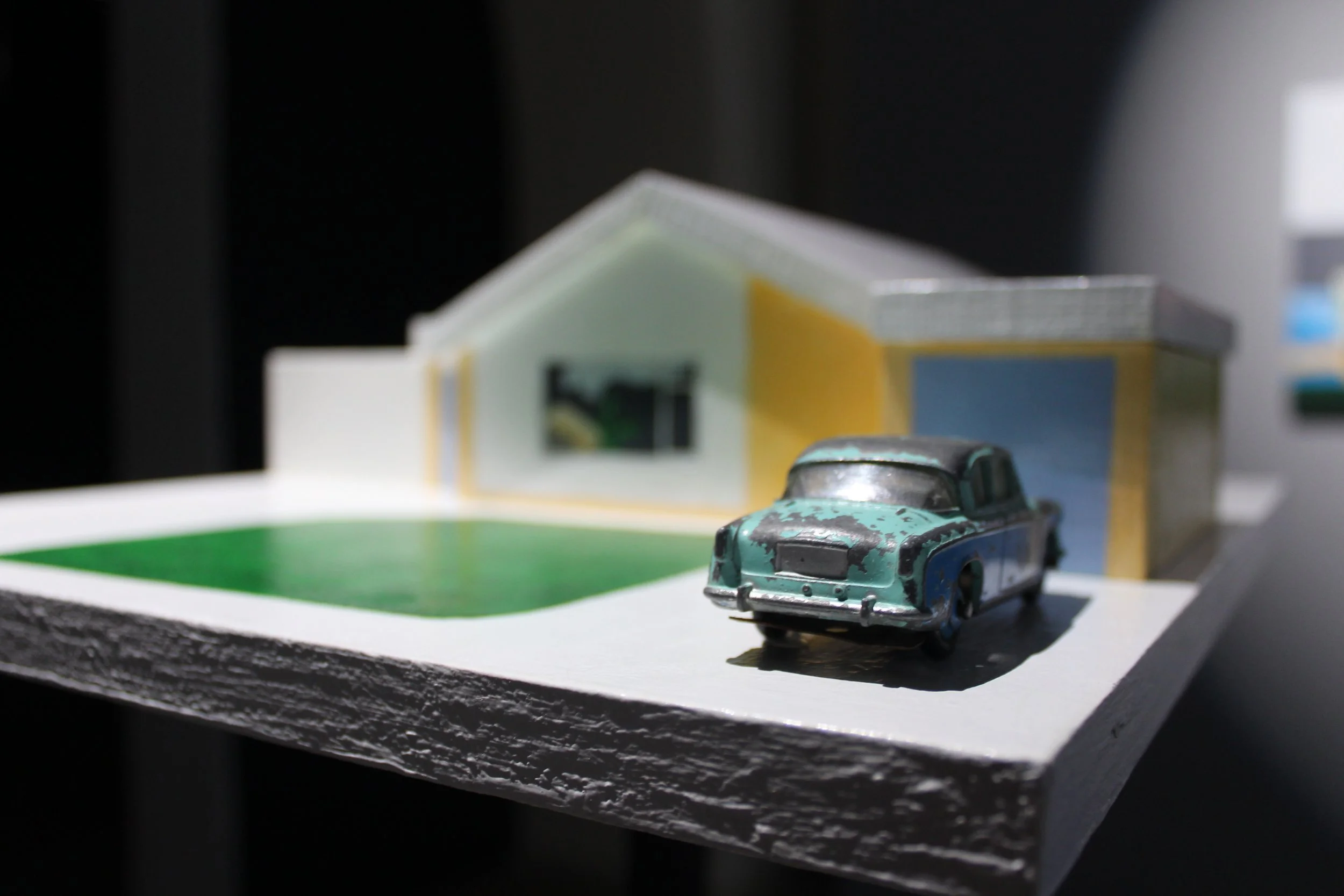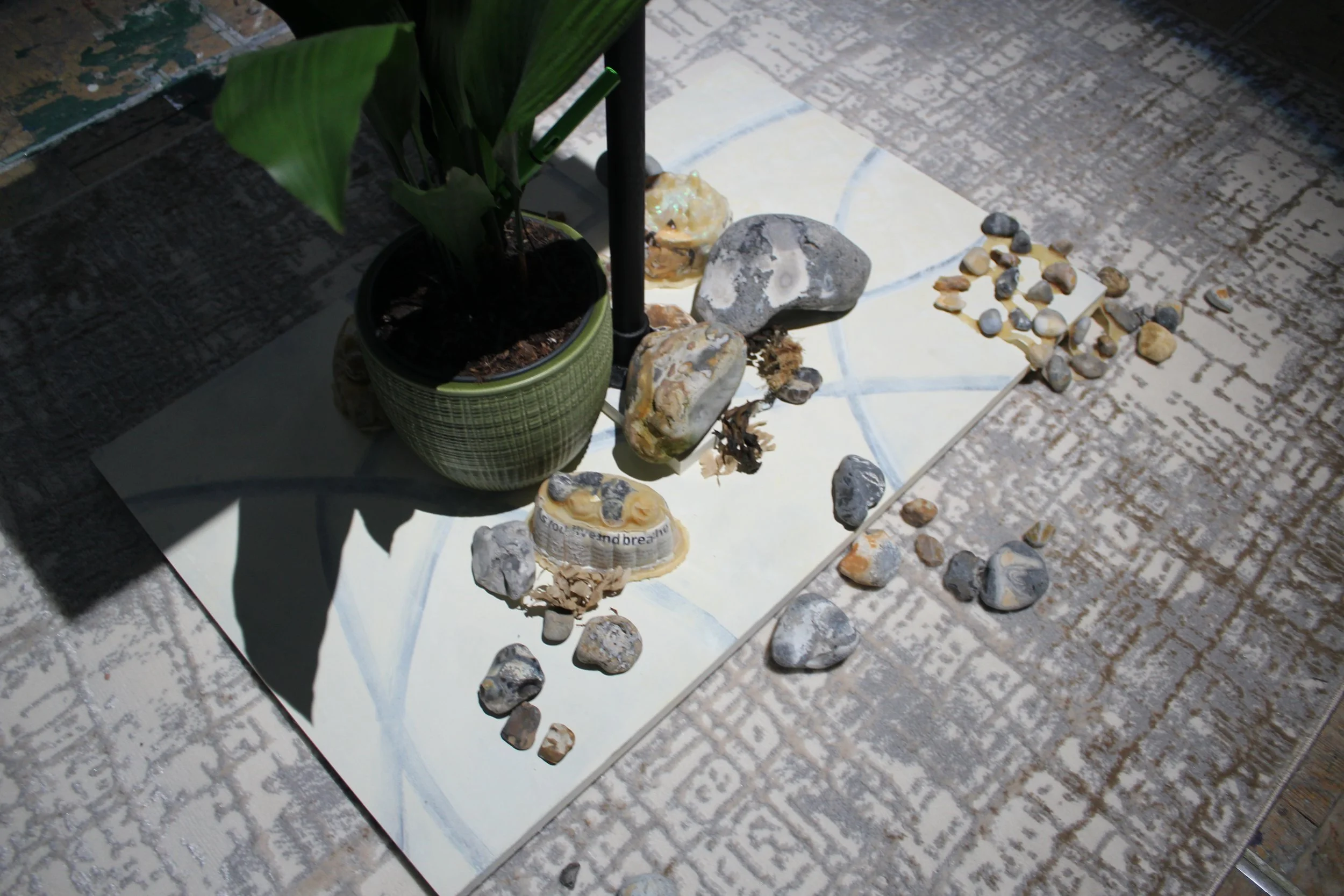Final major project
2023
Contents:
Artist Introduction
Projected Audio-video production
Scaled installation
Supporting Art work
References
This final major project titled ‘Living the Dream’ explores human relationships and the field of constructed space, looking at past times and the prediction of future thinking in alignment with social and political contexts.
image: Eyres Monsell Estate, 1950s, Leicester. Leicester City Council
1. Artist Introduction
The post-war family home in Britain, with borrowed ideas taken from American ideals of the suburban house, can be seen in many housing developments across Britain. ‘Living the Dream’ explores the seaside retirement home of my grandparents, a bespoke build in 1964. Set in the social and political context, this is an augmented vision, a dream home in a brand-new consumer world.
Through the Research in Practice module, the origins of the design and place of my first childhood home were discovered. Architectural and artistic theories of spatial practice were combined with the notion of embodied memory, were taken to investigate the childhood memories of this home, on a mid century built housing estate in Leicester.
Undertaking further and deeper research, I have discovered the same developer/builder’s architect for this housing estate, designed the seaside bungalow for my grandparents in 1964, when they moved to the North Norfolk coast. My grandparents visited the show homes of the developer (George Calverley & Sons Ltd) in Leicester in 1963, and asked them to design a bungalow for a specific plot on a cul-de-sac in a seaside town. Calverley made many trips the USA to undertake an extensive study of the American Home building industry and brought back many ideas and concepts for house design.
The intention of this project, therefore, is to critically demonstrate and contribute through art practice, a visual depiction of a domestic environment using an auto-ethnographic approach and the parallel of the past and its fears of the time. The hopes and fears are said to resonate keenly with the now. As well as the underlying cold war, anxieties lay in suburbia regarding new ways of living.
‘The domestic sphere engendered new expectations regarding social behaviour, modes of living, and forms of dwellings.’….'Anxieties generated by and through changing behaviours and contained just below their surface helped to ensure that changes remained always reined in by norms in formation and transformation.’ (Schulenfrei. 2012)
This is pertinent in our current time with an atmosphere of political tensions, war, climate change and modern technology. By taking a retrospective of the past, are we learning from the constructs of our home environments for future society? What would we do if faced with another national rebuild following a major catastrophe? In a fast-paced digital world there is the danger of a ‘cultural amnesia’ (Pallasmaa J. 2009).
Without engagement and the slower (and bodily) experiences of childhood in lieu of immersive screen technology. In the future, we might forget how it was altogether?
The project consists of three interconnecting methodological approaches - a projected collaged video animation, a 3-D scaled installation and a series of supporting art work.
2. projected audio-video
The projection displays family life at the seaside and mixes the past with the present sending us to a new dream home at the seaside, in a brand new consumer world. All artist’s photography and beach sound recording taken on location on the north Norfolk coast.
Living the Dream video projection
A series of stills from the video below show the family extracted from past and current photographs. These combined with images - the scaled bungalow installation, paintings and graphics tell a story of new beginning at the seaside for my grandparents. The song, Enchanted performed by the Platters (1959, written by Buck Ram) is deliberately chosen as a classic that epitomises the American dream. The platters were an American band and the dream was brought to Britain.
3 . Scaled Installation
Taking the ‘Practical Householder’ approach to the making of a scaled down bungalow with crafted painted plywood, the new home is symbolic and stylized – an augmented form of the simple, uncomplicated and uninterrupted aesthetic of the post war era. In its barest state, the only elements left follow the political intentions and ethos of the period – the house, the lawn and the car.
eye level view of bungalow frontage - handmade scaled installation from 12mm thick blocks of plywood only with brush strokes on show.
Here, there is reinvention of the ‘designed’ home with a scaled model, a model that is symbolic, augmenting the modular, the modern, the simple lines, the social & political codes of the era and the ‘newness’ of the post war modern
“As the ‘normal’ size human body provides the measure which determines our social and environmental environment, a sudden disruption in scale can have both intriguing and life-threatening effects.”
“The scaled down model ‘skews the space relations of the everyday world’ and ‘an object consumed’
”
The sunbeam rapier dinky toy car sits on the driveway -the only part of bungalow scene that is aged and battered by time
The aspidistra plant is a literary provocateur for the fears of that time. As long as the aspidistra keeps flying, taken from the novel Keep the Aspidistra Flying (Orwell G. 1936), the anxieties are hidden behind the seamless appearance. The plant is used as a pacifier in an anxious world. Also known as the cast iron plant – reliable, low maintenance and impossible to kill, it acts as a battering ram for the anxieties of suburban living.
The character Gordon Comstock on Orwell’s Keep the Aspidistra Flying takes out his frustrations of being an unsuccessful poet on the aspidistra plant in his meagre lodgings. (The pot plant was popular in the Victorian household and often symbolised middle class decency ). At one stage he abuses and attempts to kill the plant with a fountain pen in the stem and stubbing out his cigarette end on the leaves.
4. supporting art work
Art work further characterises this ideology by augmentations and abstractions of the context of the time, combined with family life using historical records. A page is taken from the Calverley Homes brochure of the early 1960s and remade using inserted text between original to highlight the anxieties behind the façade. Below we see the plan is substituted with a collaged plan and drawing of local beach geology (Flint Paramoudra).
An invention of a page from a home developer brochure (Calverley & Sons of Leicester) in the style of the late 1950s/early 1960s.
My grandparents in Leicester, in their sunbeam rapier in the 1950s
Below, 100 x 50cm acrylic illustration ‘DB7 SA’ and 91 x 61cm ‘A New beginning’. The aspidistra features as a reminder to the anxieties in each vision. The move to the cost in the Sunbeam Rapier and a family ritual of a trip to the beach is celebrated in both video and painting.
'DB& SA’ or ‘A day at the beach’ is an interpretation of a scene from the 1960s. My mother is with her parents in 1964 and they are outside their bungalow in Cromer. They have just returned from a day at the beach. The painting depicts a classic domestic scene and has been taken from an historical photograph and the scaled model of the bungalow made in blocks of wood only. The semi-abstract depiction deliberately uses flat areas of classic coastal colours and strong shadows to bring to the forefront the ideologies of the post war single family dwelling – simplicity, practicality and presentation.
‘A new beginning’ shows my grandparents in their sunbeam rapier, broken down into four shades and colours using the Notan technique, even the over-simplicity overspills into every object and being.
A series of eleven ‘photo fictions’ using current photographs, historical photographs and scaled installation of the bungalow
5. References
Key Bibliography:
Dunne.A & Raby F., (2013) Speculative Everything. The MIT Press
Fraser M. & Kerr J. (2007) Architecture and the ‘Special Relationship’, The American influence on Post-War British Architecture’. Routledge
Kennedy J.C. et all (1958) Modern Home and Homemaking Illustrated. Odhams Press Ltd.London.
Lane.B (2015) Houses for a New World: Builders and Buyers in an American Suburb 1945-1965. Princeton University Press
Noble, R., (2009). Utopias: Documents of Contemporary Art. Whitechapel Gallery & MIT Press
Perry.G (2013). Playing at Home - The House in Contemporary Art. Reaktion Books.
Smithson, A. & Smithson, P. (1994) Changing the art of inhabitation : Mies’ pieces, Eames’ dreams, The Smithsons. London: Artemis.
Massey. A (1995) The Independent Group: Modernism and Mass Culture in Britain, 1945-59. Manchester University press
Macleod.K & Holdridge.L Eds. (2006) Thinking Through Art: Reflections on Art as Research. Routledge
Rendell, J (2006) Art and Architecture: A Place Between. I.B.Tauris
Schuldenfrei, R. ed., 2012. Atomic dwelling: anxiety, domesticity, and postwar architecture. Routledge.
Weiss, M., 2019. Making It Up: Photographic Fictions. National Geographic Books.
Key Articles/websites
Baldwin. E. Drawing in layers: How Architectural Collage Can Expand Your Design Possibilities
https://architizer.com/blog/practice/details/rethinking-architectural-collage/
accessed 10-03-23
Bartas. M.,ed. VIS Issue no.3 History Now
https://www.en.visjournal.nu/theme-history-now-3
accessed 06-04-23
Cardiff J & Bures Miller.G (2005) Opera for a Small Room
https://cardiffmiller.com/installations/opera-for-a-small-room/
accessed 23-04-23
Faiz Abbas (2022) Postwar Modern, Age of many Posts, and Freedom of Expression
https://www.barbican.org.uk/read-watch-listen/postwar-modern-age-of-many-posts-and-freedom-of-expression (accessed 17-04-23)
(2022) In Conversation: Abbas Zahedi, Charlotte Flint and Jan Kaminski
accessed 17-04-23
Harju B, Picture Windows: Architecture of Privacy and Surveillance. e-cadernos CES [Online], 27 | 2017, posto online no dia 15 junho 2017, consultado o 28 fevereiro 2023.
URL: http://journals.openedition.org/eces/2221; DOI: https://doi.org/10.4000/eces.2221
Accessed 28-02-23
https://journals.openedition.org/eces/2221#quotation
Highmore, B. (2006). Rough Poetry: “Patio and Pavilion” Revisited. Oxford Art Journal, 29(2), 269–290. http://www.jstor.org/stable/3841016
accessed 24-04-23
Houssame Eddine Hsain 2021Why your home is not really yours
Domestic space viewed through the lens of Architectural discourse
https://uxdesign.cc/why-your-home-is-not-really-yours-63ee63d79918
accessed 30-01-23
Katwala. S (2003) How not to Succeed:An introduction to Orwell's Keep the Aspidistra Flying, the first modern classic title for our new Observer Book Group
https://www.theguardian.com/books/2003/jul/06/georgeorwell.classics
ART DWELLS: HEIDEGGER’S CONCEPT OF DWELLING AND THE SPATIAL RELATIONS BETWEEN ARCHITECTURE AND CONTEMPORARY ART IN TWO ARTWORKS AT INSTITUTO INHOTIM (BRAZIL) (2018)1Oculum Ensaios, vol. 16, no. 3, pp. 603-621, 2019, Pontifícia Universidade Católica de Campinas, Programa de Pós-Graduação em Urbanismo
Lane.B (2015) Houses for a New World: Builders and Buyers in an American Suburb 1945-1965.Princeton University Press
Langhamer, C. (2005). The Meanings of Home in Postwar Britain. Journal of Contemporary History, 40(2), 341–362. http://www.jstor.org/stable/30036327
Mollard.M eds (2022) Editorial. The Architectural Review 1497, December 2022/January 2023. P3.
Pezolet, N. (2009). “Signs of inhabitation”: The Critical Legacies of Patio and Pavilion. Thresholds, 35, 44–49. http://www.jstor.org/stable/43876566
Accessed 24-04-23
Porteous. R (2022) What the manifesto manifests: Fredric Jameson, Wyndham Lewis, and the problem with ‘An American Utopia’, Textual Practice, 36:6, 909-927.
https://doi.org/10.1080/0950236X.2020.1839955
Smithson, A., & Smithson, P. (2002). “Patio and Pavilion” Reconstructed. AA Files, 47, 37–44. http://www.jstor.org/stable/295442760
Sturlaugson.B (2019) Critical Spatial Practice
https://www.societyandspace.org/forums/critical-spatial-practice
Accessed 30-04-23
Serrano, Magdalena & Fuertes, Pere. (2020). About Inhabiting: Subjects, Objects and Habitable Space. Architecture. 15. 9054. 10.5821/ace.15.44.9054.
https://www.researchgate.net/publication/347943880_About_Inhabiting_Subjects_Objects_and_Habitable_Space/citation/download
accessed 21-04-23
Science Museum (2020) A Brief History of DIY
https://www.sciencemuseum.org.uk/objects-and-stories/everyday-wonders/brief-history-diy
accessed 29-07-23
Thurley. S (2013) Coming to Terms with Modern Times: English Architecture in the Post War period. Gresham College
University of Leicester. The Post War History of Leicester - Housing
https://leicester.omeka.net/exhibits/show/postwar/housing
https://www.tate.org.uk/art/artists/robert-therrien-2312/robert-therrien-objects-and-stories
accessed 01-03-23
https://www.tate.org.uk/art/art-terms/geometry-fear
accessed 20-03-23
http://www.michaelrakowitz.com/white-man-got-no-dreaming
accessed 24-04-23
https://criticalspatialpractice.co.uk/dissolving-the-dwelling-2021-2/
(accessed 24-04-23)
(1991) Pleasures and Terrors of Domestic Comfort, MOMA
https://www.moma.org/calendar/exhibitions/347


































